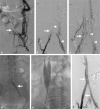Endovascular Therapy for Lower Extremity Chronic Deep Venous Occlusive Disease: State of Practice
- PMID: 30402016
- PMCID: PMC6218266
- DOI: 10.1055/s-0038-1669963
Endovascular Therapy for Lower Extremity Chronic Deep Venous Occlusive Disease: State of Practice
Figures



Similar articles
-
"Modern Endovascular Therapy".World J Surg. 2021 Dec;45(12):3493-3502. doi: 10.1007/s00268-020-05875-7. Epub 2020 Nov 22. World J Surg. 2021. PMID: 33225390 Review.
-
Endovascular Interventions for Acute and Chronic Lower Extremity Deep Venous Disease: State of the Art.Radiology. 2015 Jul;276(1):31-53. doi: 10.1148/radiol.2015132603. Radiology. 2015. PMID: 26101920 Free PMC article. Review.
-
Endovascular management of venous thrombotic and occlusive diseases of the lower extremities.J Vasc Interv Radiol. 2003 Apr;14(4):405-23. doi: 10.1097/01.rvi.0000064849.87207.4f. J Vasc Interv Radiol. 2003. PMID: 12682198 Review.
-
Open surgical repair versus endovascular therapy for chronic lower-extremity occlusive disease.Annu Rev Med. 2003;54:269-83. doi: 10.1146/annurev.med.54.101601.152509. Epub 2001 Dec 3. Annu Rev Med. 2003. PMID: 12414919 Review.
-
A systematic review of venous stents for iliac and venacaval occlusive disease.J Vasc Surg Venous Lymphat Disord. 2020 Jan;8(1):145-153. doi: 10.1016/j.jvsv.2019.08.015. Epub 2019 Nov 5. J Vasc Surg Venous Lymphat Disord. 2020. PMID: 31699668
Cited by
-
Novel mechanical thrombectomy device used to restore patency to chronically occluded deep venous bypasses.J Vasc Surg Cases Innov Tech. 2025 May 24;11(4):101862. doi: 10.1016/j.jvscit.2025.101862. eCollection 2025 Aug. J Vasc Surg Cases Innov Tech. 2025. PMID: 40641516 Free PMC article.
-
Hybrid CT-angiography to facilitate lower extremity sharp venous recanalization: a novel approach to a common procedure.CVIR Endovasc. 2020 Oct 8;3(1):51. doi: 10.1186/s42155-020-00145-y. CVIR Endovasc. 2020. PMID: 33030614 Free PMC article.
References
-
- Raju S. Treatment of iliac-caval outflow obstruction. Semin Vasc Surg. 2015;28(01):47–53. - PubMed
-
- Williams D M. Iliocaval reconstruction in chronic deep vein thrombosis. Tech Vasc Interv Radiol. 2014;17(02):109–113. - PubMed
-
- Neglén P, Raju S. Balloon dilation and stenting of chronic iliac vein obstruction: technical aspects and early clinical outcome. J Endovasc Ther. 2000;7(02):79–91. - PubMed
-
- Neglén P, Darcey R, Olivier J, Raju S. Bilateral stenting at the iliocaval confluence. J Vasc Surg. 2010;51(06):1457–1466. - PubMed

